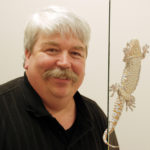Robert J. Full, Int. Biol., UC Berkeley
Robert J. Full is a Chancellor’s and Goldman Professor in the Department of Integrative Biology at the University of California at Berkeley. He received his PhD from SUNY Buffalo and was a postdoctoral researcher and lecturer at the University of Chicago. His primary rsearch interests reside in the area of comparative biomechanics and physiology, quantifying whole animal performance, and locomotion in particular, as it relates to an animal’s structure, physiology, and behavior. He uses biomechanical, computer simulation (dynamic musculo-skeletal modeling), physical modeling (robot and artificial muscle construction), isolated muscle, biochemical, whole-animal exercise physiology, and field-tracking techniques to seek general design principles for species that have evolved different solutions to the problems of locomotion and activity in general. Animals such as crabs, cockroaches, ants, beetles, scorpions, centipedes, geckos, and salamanders show tremendous variation in body shape, gas transport system, leg number, musculoskeletal arrangement and mode of movement. Diversity enables discovery. These “novel” biological designs serve as natural experiments to probe for basic themes concerning the relationship between morphology, body size, energetics, dynamics, control, stability, maneuverability, maximum speed and endurance. In his thirty years at Berkeley, Professor Full has also led an international effort to demonstrate the value of integrative biology and biological inspiration by the formation of interdisciplinary collaborations among biologists, engineers, and mathematicians from academia and industry. Professor Full is founder and director of CiBER, the Center for interdisciplinary Bio-inspiration in Education and Research, the Editor-in-Chief of the journal Bioinspiration and Biomimetics, a science advisory board member of the new journal, Science Robotics, was the Principal Investigator on an NSF Integrative Graduate Education and Research Traineeship on Bio- and Bio-inspired Motion Systems Operating in Complex Environments, and serves or has served on the advisory boards of Switzerland’s National Competency Center for Robots, Harvard’s Wyss Institute for Biologically Inspired Engineering, Research Corporation for Science Advancement, and the Annual Biomedical Research Conference for Minority Students (ABRCMS). Professor Full’s programmatic theme is Diversity Enables Discovery where teaching and research are inseparable. He directs the Poly-PEDAL Laboratory, which studies the Performance, Energetics and Dynamics of Animal Locomotion (PEDAL) in many-footed creatures (Poly). His discoveries of fundamental principles in motion science led to the design of animal inspired neural control circuits, artificial muscles, search-and-rescue robots, and gecko inspired self-cleaning, dry adhesives. Professor Full has authored over one hundred and fifty contributions and has delivered over three hundred national and international presentations. His efforts in education has led to discovery- based courses, undergraduate research programs, service toward equity and inclusion, and outreach through web presentations, museum exhibits, radio, and TV. Professor Full received an NSF Presidential Young Investigator Award, Berkeley’s Distinguished Teaching Award, was named a Mentor in the Life Sciences, and was elected to the American Association for the Advancement of Science, and the American Academy of Arts and Sciences under the new category, Emerging Fields.
Learn about our two Decals!
 Click here to find out more about our Fall Bioinspired Design Decal and our Spring Bioinspired Design in Action Decal – ALL MAJORS are welcome.
Click here to find out more about our Fall Bioinspired Design Decal and our Spring Bioinspired Design in Action Decal – ALL MAJORS are welcome.Berkeley BioDesign Community
 Click here to learn about the BioD: Bio-Inspired Design @ Berkeley student organization or here to signup for more info.
Click here to learn about the BioD: Bio-Inspired Design @ Berkeley student organization or here to signup for more info.Search
Student Login




I imagine that the neurological circuits underlying these processes are governed by both 2d spacing maps with their brains as…
to reduce the impact of car accidents, it may be possible to study the force diverting physics of cockroaches to…
you see this type of head-bobbing stability in many avian creatures related to pigeons like chickens. the head ability to…
not like they taught horses how to run! this is an example of convergent evolution where both sea creatures and…
The brain functions in a similar way with neuronal connections. our brains are able to utilize the multiplicity of connections…